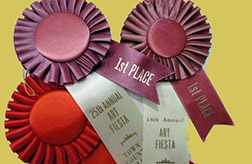
Among the many things discussed this weekend with 3 artist friends, during our 8 hour round trip journey to the San Francisco Bay area, was judging in art competitions. We belong to a local chapter of a San Francisco based art organization and had volunteered to transport our member paintings up and back from the annual exhibit held at our headquarters gallery.
We’re, all four, often asked to judge various competitions or to be involved with the selection of judges. I, personally, believe in a 3 judge system. Having a single judge, I feel, is unfair to the entrants, as it’s very one-sided, reflecting the nonobjective personal tastes and opinions of a single individual. While having two judges is a little better, with the decision making a bit more objective, the decision weighting is now just 50/50 and the two judges decisions can cancel each other out. A piece that one judge loves, can be knocked out of prize competition because the other judge doesn’t agree. With 3 judges, prize winning works are selected through majority decisions, each single judges judgement call is tempered by the judgement of the other two. I feel so strongly about the fairness of the 3 judge system, that I consider this in deciding whether or not to participate in a competition.
 Another central topic surrounding our competition judging discussion was the importance of who the selected judges are: their background and expertise. Organizations have a lot of tasks on their plate when putting together an exhibit or competition and too often judge selection it made quickly, without adequate consideration, in an effort to mark the task done and move on to one of the other items on the list. The problem is compounded if you’re making the selection for an organization who offers competitions annually or even more frequently. In attempts to avoid using the same qualified judges too often, it’s easy to relax standards a bit, in the name of adding variety to the judging panel. Don’t do it! Who is selected to judge the competition is the single most import decision made in an art competition. Unqualified judges make for unfair, competitor head-scratching decisions.
Another central topic surrounding our competition judging discussion was the importance of who the selected judges are: their background and expertise. Organizations have a lot of tasks on their plate when putting together an exhibit or competition and too often judge selection it made quickly, without adequate consideration, in an effort to mark the task done and move on to one of the other items on the list. The problem is compounded if you’re making the selection for an organization who offers competitions annually or even more frequently. In attempts to avoid using the same qualified judges too often, it’s easy to relax standards a bit, in the name of adding variety to the judging panel. Don’t do it! Who is selected to judge the competition is the single most import decision made in an art competition. Unqualified judges make for unfair, competitor head-scratching decisions.
Selecting judges with expertise specific to the flavor of your competition is another important consideration. If you’re mounting a representational art only competition, you don’t want to bring in judges known for their fantastic abstract work. If you’re including an abstraction category in your competition, you don’t want to only invite hardcore realists to do your judging.
While a lot of this is just common sense, when the calls for entry have gone out and you’re under the gun to get everything done before the posted show opening night date, it’s easy to use up the time necessary to consider and vet appropriate judges. You owe it to yourself, organization and competitors to never let that happen.

I agree, sometimes the number system works, and then can all get together and discuss points.
When I was in Exhibits in Orange Co. . always checked to see who was Judging.. it gave a clue as to how the general look of the Exhibit would be.. Not showing a Chinese Brush painting in an exhibit where the artist/ judge likes abstracts just never works.